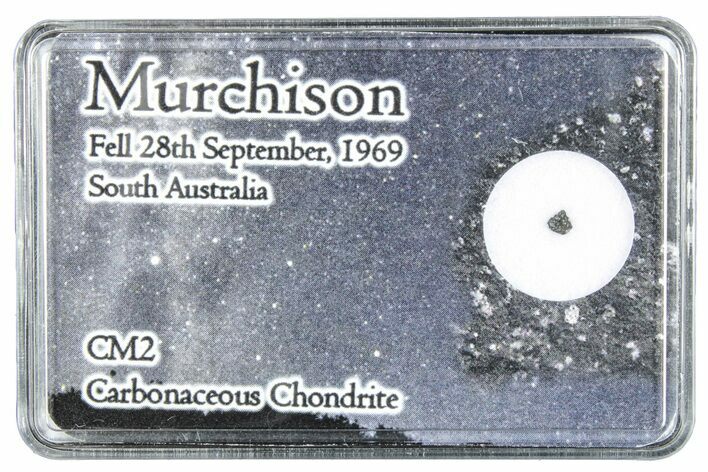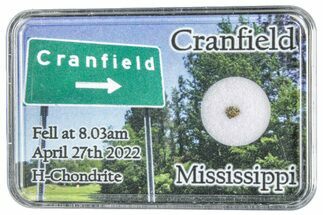This Specimen has been sold.
.09" Murchison Chondrite Meteorite Fragment - Australia
This is an incredibly rare specimen: a .09" wide fragment of the Murchison meteorite of Australia! It comes in a bespoke display case.
Murchison is among the more famous chondrites to fall in the last century, and one of the largest CM2 chondrites to fall on Earth. It made landfall near the town of Murchison in Victoria, Australia at about 11:00AM local time on September 28, 1969, and was soon collected. Eventually about 100 kilograms of fragments were found in a strewn field covering about five square miles: some had even punched holes through the roof of a barn! Because of its abundant mass and witnessed fall, Murchison has been a landmark specimen for meteorite research.
Like other members of the CM2 carbonaceous chondrite group, Murchison has some highly unusual features worthy of decades of study. Firstly, Murchison is old: silicon carbides and other presolar grains contained within it have been dated to about 7 billion years old. That's almost 3 billion years older than our own solar system! It is also about 8 percent water, owing to its many hydrated minerals found throughout. Murchison is also unusual for its abundance of organic compounds such as amino acids, as well as volatile compounds and hydrocarbons that give specimens a faintly earthy or even alcoholic scent. To date, over 70 amino acids have been identified from this meteorite, only 19 of which are found on Earth! Scientists are still publishing papers today about the chemical mysteries this meteorite contains.
Murchison shares a similar look to most other CM2 chondrites. It contains varied whitish to gray clasts and rounded chondrules within a dark gray to black matrix. Occasionally, irregular-shaped pockets of calcium-aluminum rich inclusions (CAIs) may also be found.
Like other members of the CM2 carbonaceous chondrite group, Murchison has some highly unusual features worthy of decades of study. Firstly, Murchison is old: silicon carbides and other presolar grains contained within it have been dated to about 7 billion years old. That's almost 3 billion years older than our own solar system! It is also about 8 percent water, owing to its many hydrated minerals found throughout. Murchison is also unusual for its abundance of organic compounds such as amino acids, as well as volatile compounds and hydrocarbons that give specimens a faintly earthy or even alcoholic scent. To date, over 70 amino acids have been identified from this meteorite, only 19 of which are found on Earth! Scientists are still publishing papers today about the chemical mysteries this meteorite contains.
Murchison shares a similar look to most other CM2 chondrites. It contains varied whitish to gray clasts and rounded chondrules within a dark gray to black matrix. Occasionally, irregular-shaped pockets of calcium-aluminum rich inclusions (CAIs) may also be found.
About CM2 Carbonaceous Chondrites
Carbonaceous chondrites are a rare and scientifically significant type of stony meteorite, representing only about 4% of all meteorites found on Earth. These meteorites are considered to be some of the oldest materials in the solar system, dating back over 4.5 billion years. They are composed primarily of silicate minerals but are unique for their high levels of carbon, organic compounds, and water-bearing minerals, offering a glimpse into the conditions of the early solar system.
Theys are divided into several groups, including CI, CM, CR, CO, CV, and CK, each representing different compositions and histories. CI and CM chondrites are the most primitive and are often rich in organic compounds. CI chondrites, like the Orgueil meteorite, are extremely rare and contain the highest known concentrations of organic materials among meteorites.
A CM2 chondrite is a type of carbonaceous chondrite meteorite with a high abundance of carbon and water-bearing minerals. The “CM” classification stands for the "Mighei-type," named after a meteorite that fell in Mighei, Ukraine. The "2" in CM2 indicates a specific petrologic (textural) type, meaning it has experienced low levels of alteration from water or heat compared to other chondrites, preserving more primitive materials.
Carbonaceous chondrites are a rare and scientifically significant type of stony meteorite, representing only about 4% of all meteorites found on Earth. These meteorites are considered to be some of the oldest materials in the solar system, dating back over 4.5 billion years. They are composed primarily of silicate minerals but are unique for their high levels of carbon, organic compounds, and water-bearing minerals, offering a glimpse into the conditions of the early solar system.
Theys are divided into several groups, including CI, CM, CR, CO, CV, and CK, each representing different compositions and histories. CI and CM chondrites are the most primitive and are often rich in organic compounds. CI chondrites, like the Orgueil meteorite, are extremely rare and contain the highest known concentrations of organic materials among meteorites.
A CM2 chondrite is a type of carbonaceous chondrite meteorite with a high abundance of carbon and water-bearing minerals. The “CM” classification stands for the "Mighei-type," named after a meteorite that fell in Mighei, Ukraine. The "2" in CM2 indicates a specific petrologic (textural) type, meaning it has experienced low levels of alteration from water or heat compared to other chondrites, preserving more primitive materials.
TYPE
Carbonaceous Chondrite (CM2)
LOCATION
Murchison, Victoria, Australia
SIZE
.09" wide
CATEGORY
ITEM
#286081
 Reviews
Reviews












